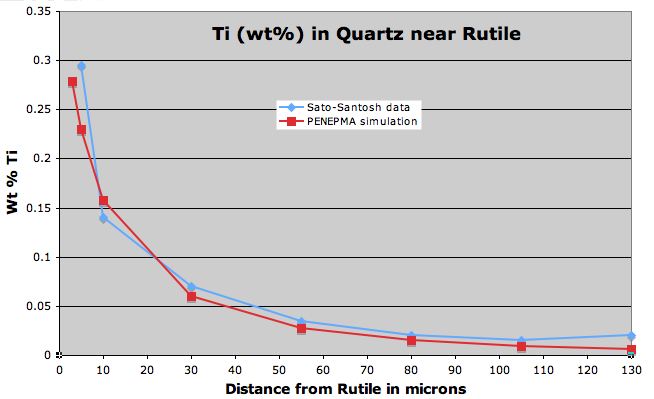
A report by John Fournelle, Dept of Geoscience, University of Wisconsin-Madison <johnf@geology.wisc.edu>
A recent publication* used EPMA (15 kV accelerating voltage), to acquire Ti contents in quartz very close to rutile and used that data to infer temperatures. It can be demonstrated that the authors did not correctly account for secondary fluorescence. However, they acquired an excellent data set (in their figure 5) to evaluate possible secondary fluorescence in quartz, at distances from 3-5 microns, out to 130 microns, away from a large rutile inclusion.
Historically secondary fluorescence has been very difficult to unravel conclusively in EPMA. However, with the recent development of the PENEPMA Monte Carlo program**, it is now relatively easy to determine quantitatively the amount of secondary fluorescence in an EPMA sample.
I have run 8 PENEPMA simulations, of a simple diffusion couple geometry, with a vertical boundary between TiO2 and SiO2, at distances from 3 to 130 microns out from the TiO2, using the same EPMA condition (15 kV), for sufficient times to reach better than 2% statistical error. As shown below, there is a very good correspondence between the experimental data and the data extrapolated from Figure 5 in the Sato-Santosh paper. This strongly suggests that most, if not all, of the measured Ti in quartz is due to secondary fluorescence -- from the continuum, as there are no characteristic x-rays able to excite Ti Ka. This continuum fluorescence is well know to generate a few tenths of a % within 10 microns, and a hundred of so ppm out over 100 microns away, with the characteristic exponential drop seen here. For further examples and discussion, see Fournelle (2007a, 2007b)***

*Sato and Santosh (2007) Titanium in quartz as a record of ultrahigh-temperature metamorphism: the granulites of Karur, southern India, Mineralogical Magazine, 71(2), 143-154.
** Llovet and Galan (2003) Correction for secondary X-ray fluorescence near grain boundaries in electron microprobe analysis: application to thermobarometry of spinel lherzolites, American Mineralogist, 88, 121-130.
*** Fournelle (2007) Problems in trace element EPMA: modeling secondary fluorescence with PENEPMA, Eos Trans. AGU, 88(52) Fall Mtg Supple, Abstract V51A-0329, (also a 2.3 mb pdf of the poster) and Fournelle (2007) The problem of secondary fluorescence in EPMA in the application of the Ti-in-zircon geothermometer and the utility of PENEPMA Monte Carlo Program, Microscopy and Microanalysis, 13 (Supplement 2), 1390-1391.
Return to Secondary Fluorescence page